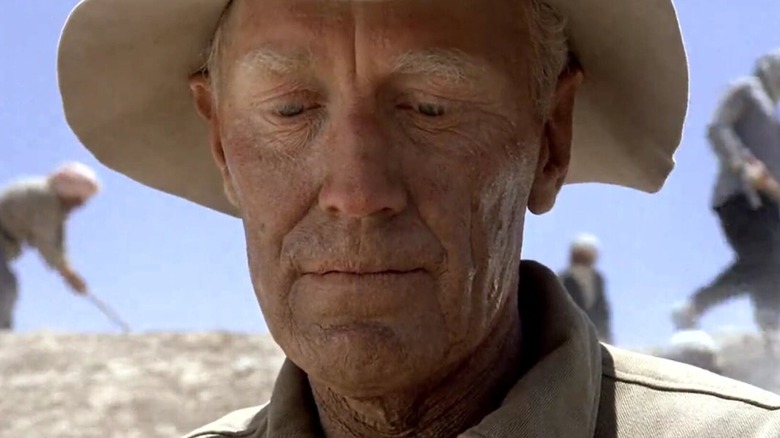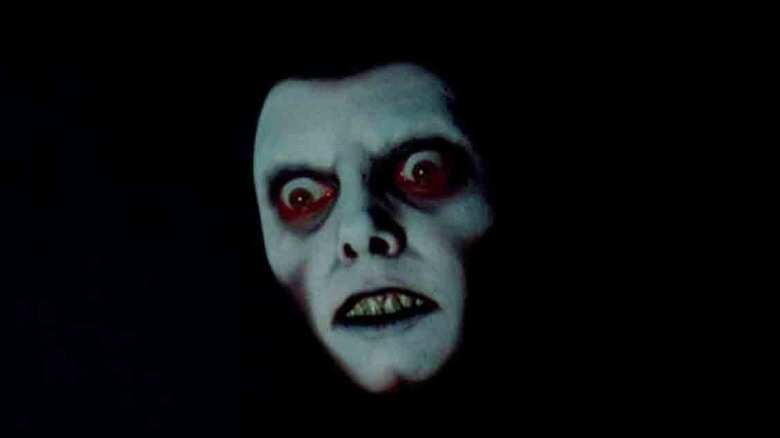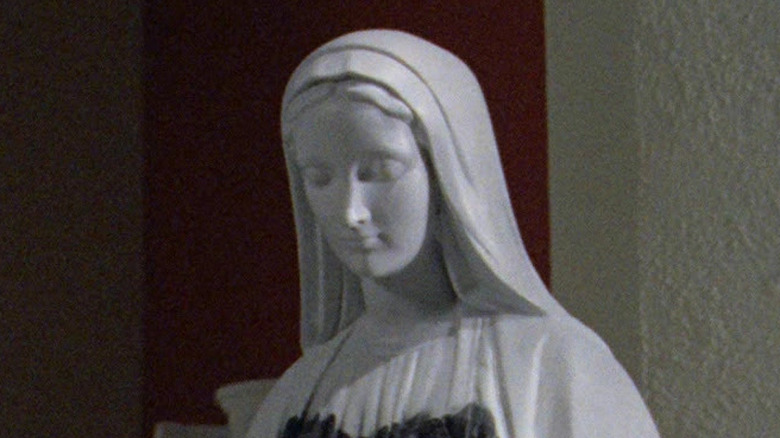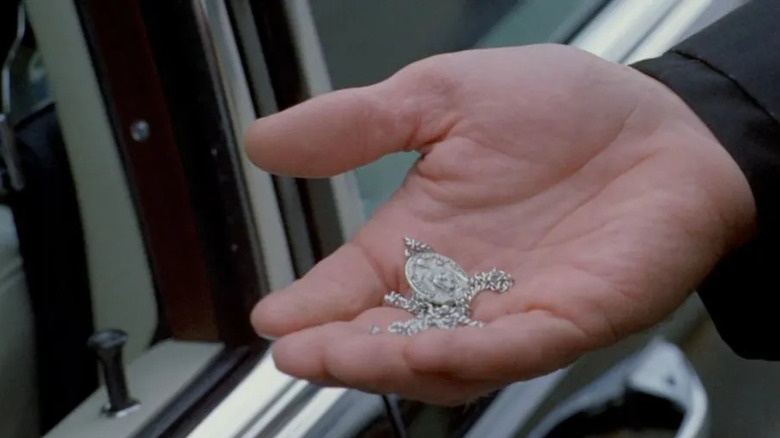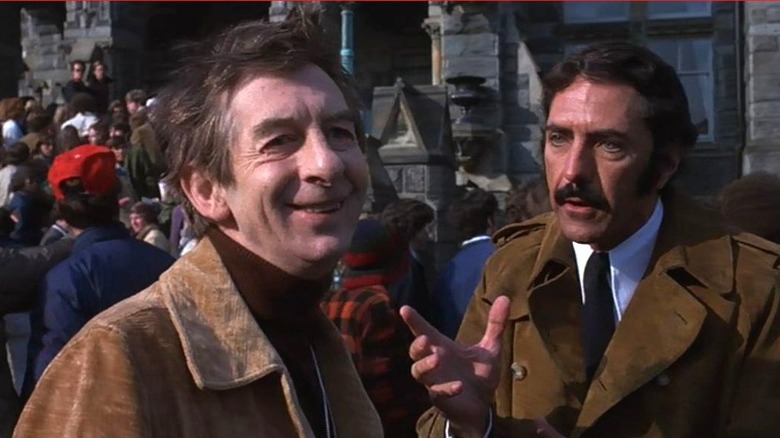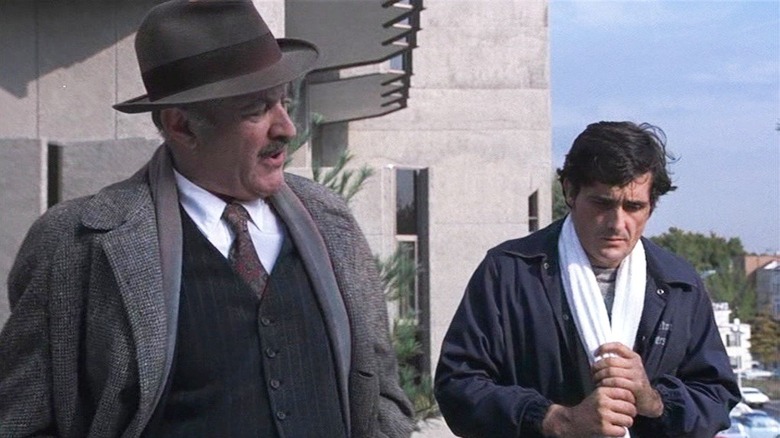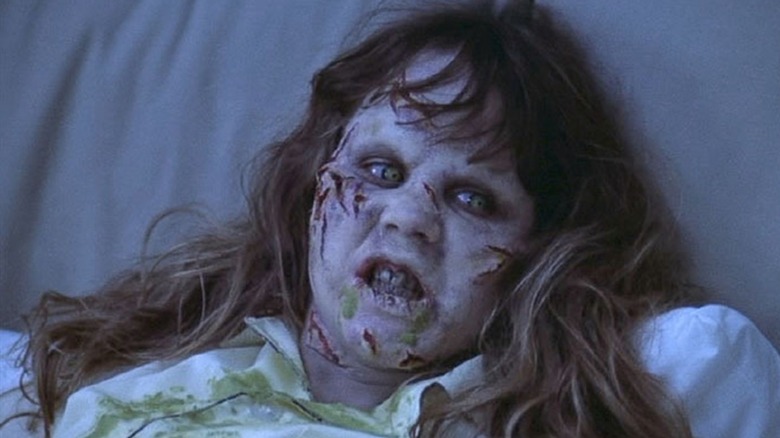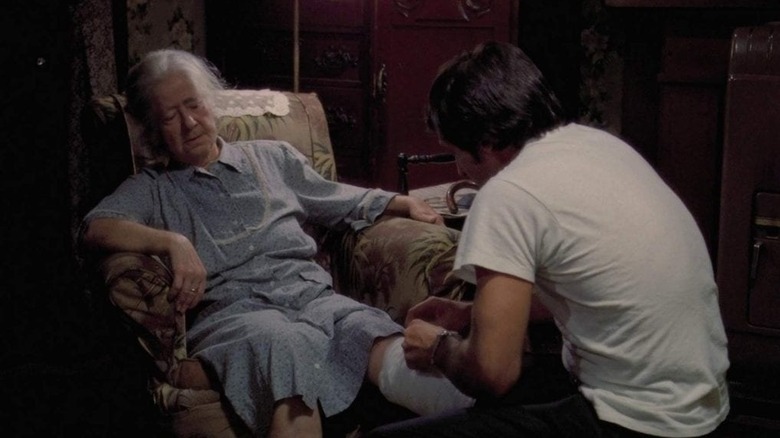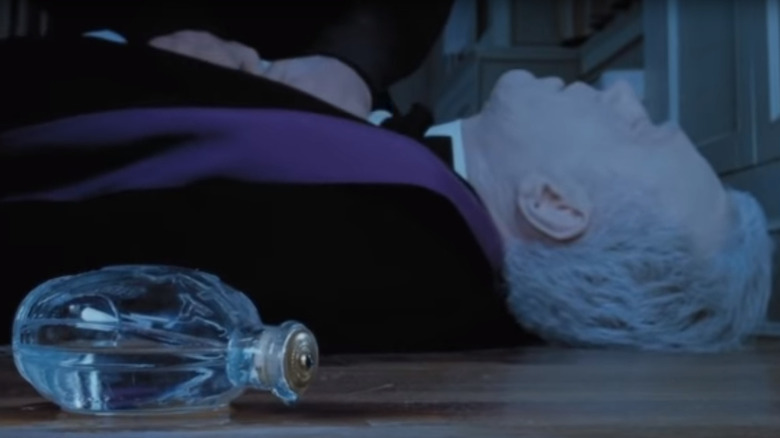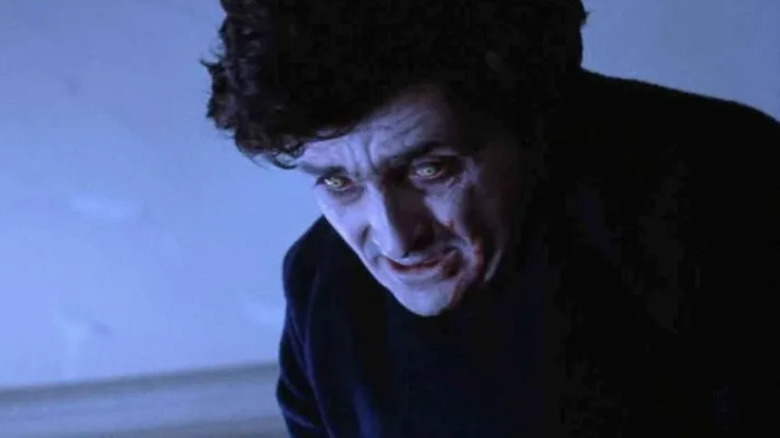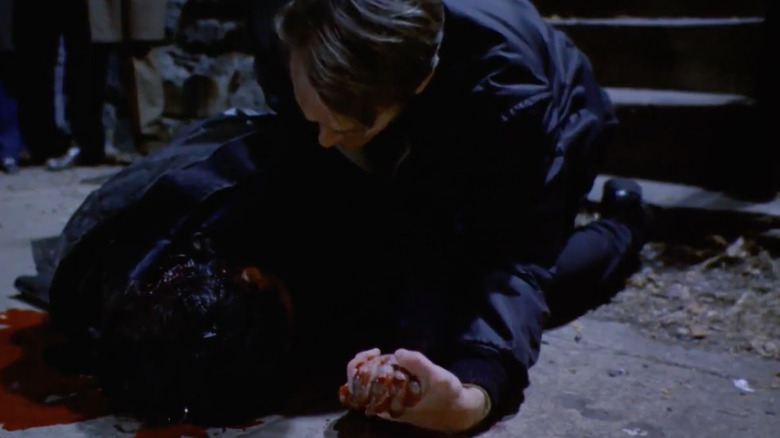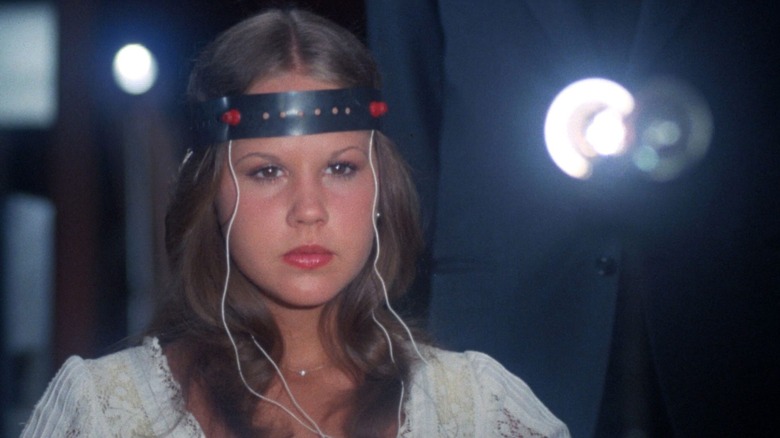Biggest Unanswered Questions From The Exorcist
One of the most critically acclaimed horror movies of all time is "The Exorcist," directed by William Friedkin and written by William Peter Blatty, based on Blatty's 1971 novel of the same name. The 1973 film follows two Catholic priests tasked with exorcizing a hellish demon that has possessed the body of a young girl named Regan MacNeil (Linda Blair). As the priests investigate whether Regan is truly possessed and perform the necessary Catholic rituals to purge the supernatural monster, they endure questions of their own faith while battling for the girl's soul.
An enormous critical and commercial success, with a number of memorably show-stopping moments, "The Exorcist" was nominated for nine Academy Awards, including Best Picture, and won two, including one for Blatty's adapted screenplay. The movie's success led to major Hollywood studios producing a wave of their own prestige horror movies, including "The Omen," while "The Exorcist" would become a franchise itself, with a growing number of sequels and a television adaptation. However, there are several questions and unresolved plot threads presented in "The Exorcist" that remain unanswered decades later, not fully addressed by the film's follow-ups.
Here are all the biggest unanswered questions from 1973's original "The Exorcist," from untold motivations for its main characters to open-ended plot threads left dangling across the franchise.
Why is there a shrine to Pazuzu in Iraq?
"The Exorcist" doesn't open in the United States but instead with an extended prologue sequence set in northern Iraq, where Father Lankester Merrin (Max von Sydow) is overseeing an archaeological dig. Among the ancient artifacts excavated during the dig is a small relic bearing the image of the Assyrian demon Pazuzu, which Merrin immediately recognizes with grave concern, hinting at a shared history between the priest and demon. While recovering from seeing the unholy relic, Merrin crosses paths with a large statue of Pazuzu erected atop a mountain, as nearby dogs react with uncontrollable fear and Merrin realizes that a literal demon from his past is about to rise again.
The origins behind such a prominent shrine to the sinister demon are never explained in the film, nor is it elaborated on again after Merrin arrives in Georgetown to perform the movie's climactic exorcism. Given how large the statue of Pazuzu looms over the Iraqi valley, it is curious why an accomplished archaeologist like Merrin wasn't aware of its existence before finding the demonic relic. Another potential explanation is that the statue appears to Merrin as a vision heralding Pazuzu's imminent possession of Regan, though this is never made explicitly clear.
How and when did Pazuzu possess Regan?
On the other side of the world, in the Georgetown neighborhood of Washington, D.C., Regan presumably attracts Pazuzu's attention through the use of a Ouija board she discovers in the house her mother Chris (Ellen Burstyn) is renting. Communicating to Regan through the seemingly innocuous tabletop reader, Pazuzu identifies itself to the girl as Captain Howdy, presenting itself as a friend, while Chris assumes the entity is a figment of Regan's imagination. Captain Howdy's introduction comes shortly before Chris starts hearing strange noises from the attic that neither she nor her servants can explain, eventually dismissing it as being caused by intrusive rodents before they notice Regan's possession.
Regan's initial possession occurs off-camera, with the young girl muttering obscenities and urinating in the middle of the living room during a house party thrown by Chris. This leaves Pazuzu's methodology for possession unknown. What makes this more puzzling is that Regan is seen violently shaking in her bed after the party, suggesting that this is when Pazuzu actually assumes control of her body. This muddled timeline is only made more complicated by the director's cut of the film released in 2000, which features additional scenes of Regan acting in a sinister fashion before the brutal bedside sequence where Pazuzu seizes further control.
Who desecrated the statue of Mary?
As Pazuzu escalates its malevolent mayhem in the MacNeil household and deepens its hold over Regan, sinister and strange occurrences take place in the wider Georgetown neighborhood heralding the demon's arrival. As Regan befriends Captain Howdy through the Ouija board, a priest at a local church discovers that its statue of the Virgin Mary has been desecrated with red paint and crude appendages attached to it in a vulgar display. This incident takes place before the party where Regan publicly urinates and Pazuzu subsequently attacks Regan in her bedroom, leaving the actual culprit of this vandalization unknown.
Pazuzu previously displayed the ability to physically interact with objects through its rumblings in the MacNeils' attic, though it is unclear if this extends to its desecration of the Mary statue without the demon having a human host. Another possibility is that it is a possessed Regan who vandalizes the statue as the first sign that Pazuzu is taking control of her, albeit in an off-screen act, even before the party. A third possibility is that Regan vandalizes the statue in a show of devotion to her presumed newfound friend, under the bidding of Captain Howdy, before Pazuzu reveals its true nature and possesses her.
What is the significance of Saint Joseph in the film?
The Pazuzu relic and statue aren't the only mysterious religious iconography that Merrin discovers at the archaeological site in Iraq, with an ancient medallion of Saint Joseph among the excavated finds. When the medallion is brought to Merrin's attention, he is visibly puzzled by its appearance and questions why such an artifact would be located at this particular site, before taking it with him to Georgetown to perform the exorcism. On the other side of the world, Father Damien Karras (Jason Miller) experiences troubled dreams before he learns of Regan's possession, with one of the images he witnesses being the same medallion of Joseph.
There is no ascribed significance to the prominent presence of Saint Joseph imagery that is explicitly cited throughout the film, even as the medallion appears in the climactic exorcism and closing scene. According to a Catholic database of the host of Saints, Joseph is a patron saint who stands in opposition to doubt and hesitation, perhaps appearing to help Karras through his crisis of faith. This is never articulated in the film itself, though Pazuzu rips the medallion off Karras as the demon seizes control of the priest's body, suggesting it is stripping him of any potential protection it may offer.
Why is Burke Dennings killed?
While Pazuzu torments anyone who enters the MacNeil household after it possesses Regan, even inflicting bodily harm, the only person the demon explicitly kills in the film is movie director Burke Dennings (Jack MacGowran). In an off-screen murder scene, Dennings has his head twisted around backwards by the possessed Regan, who proceeds to fling the director out of her bedroom window to the steep neighborhood stairs below. Dennings is far from the only character to sit alone with Regan after her possession, making it unclear why the British director is the only one horrifically killed by the demon over the course of the movie.
Dennings' murder demonstrates just how lethal Pazuzu has become, although why the middle-aged director would enter a young girl's bedroom is never fully touched on and Chris only learns of the entire incident later. The off-screen death suggests that Pazuzu could kill anyone else left in the demon's presence, although by the time Karras meets Regan, the girl is tied to her bed with restraints. Despite its reputation, "The Exorcist" features a surprisingly low body count: Dennings, unfortunately, is one the movie's few casualties for presumably being at the wrong place at the wrong time.
What becomes of the Dennings murder investigation?
After Dennings is murdered by Pazuzu, local police detective Lieutenant William F. Kinderman (Lee J. Cobb) is assigned to investigate what exactly caused the director's gruesome death. The veteran detective quickly deduces that there is something deeply disturbing taking place at the MacNeil household and that Dennings' death was no accident, though he is not privy to the full extent of Regan's possession. Kinderman interrogates Chris and several of the household help before turning his attention to Karras, after which the priest becomes involved with the MacNeil family himself to see if Regan is truly possessed.
Once Karras realizes that Regan is, in fact, possessed by a demon and the supernatural elements of "The Exorcist" accelerate, Kinderman and his murder investigation take a back seat to the main conflict. Kinderman resurfaces at the end of the film in the wake of Karras' death and is later the protagonist of 1990's "The Exorcist III," albeit investigating a completely different paranormal mystery. Despite the very public death of a prominent film director, complete with clear evidence of foul play, Kinderman's murder investigation is one that is glaringly never resolved by the end of the film.
Why does Pazuzu react to tap water?
When Karras is initially approached by an increasingly desperate Chris to investigate whether Regan is truly possessed by a demon, he is skeptical that any supernatural activity is at work. Karras meets twice with Regan privately as part of his investigation, speaking with Pazuzu directly and resorting to trickery to gauge if Regan is simply faking the demonic possession. Among the techniques Karras uses is filling a vial with tap water from the MacNeil house's bathroom, claiming it to be holy water when he confronts Pazuzu and sprinkling it on the girl.
Pazuzu reacts with caution when Karras unveils the fake holy water, fearing it to be genuine, and reacts violently when the priest douses Regan with it, never revealing any awareness of the ruse. Pazuzu displays powers of telepathy throughout the film, including the ability to read Karras' mind during his conversations with Regan, which makes the demon falling for the fake holy water all the more puzzling. The reaction to the tap water could be a feint by Pazuzu to reinforce Karras' doubt in the supernatural, but this is never articulated in the film and in contrast to the demon maintaining that its existence is real.
Is Karras' mother truly condemned to Hell?
Karras' crisis of faith throughout "The Exorcist" is largely fueled by his grief over his recently deceased mother (Vasiliki Maliaros), with Karras deeply guilty that he wasn't with her when she died in New York City. Karras strongly considers leaving his priestly duties because of his spiritual doubts, before he agrees to help Chris determine whether her daughter is possessed by a demon and warrants an exorcism. Through its telepathy, Pazuzu is able to sense Karras' fragile faith and his unresolved grief over his mother, exploiting them towards its twisted advantage when the younger priest teams up with Merrin for the exorcism.
In the midst of the ritual, Pazuzu taunts Karras with the claim that his mother's soul is being tortured in Hell, even going so far as to use her voice to express her disappointment in her son. The tactic works: Karras loses his composure and becomes heatedly emotional during the ceremony, until Merrin finally ejects his colleague from the room and attempts to proceed with the exorcism alone. It is never confirmed if Karras' mother is actually condemned to Hell or if the claim is all part of an elaborate ruse to break Karras' faith through his most personal emotional vulnerability.
Is Pazuzu responsible for Merrin's death?
When confronted by the relics and visions foreshadowing Pazuzu's return, a shaken Merrin is revealed to have a serious heart condition, taking medication to help him keep his cardiovascular condition under control. This plot point established in the prologue prominently comes into play in the movie's climax, as Merrin dies from an apparent heart attack in the midst of performing the exorcism to save Regan. To make matters worse, Merrin perishes before the ceremony is complete, leaving Pazuzu in control of the girl. Merrin dying off-camera while he is left alone with his demonic nemesis opens the possibility that there may have been supernatural elements involved in the elder priest's demise, which are never addressed directly in the film.
When Karras discovers Merrin lying dead on Regan's bedroom floor, Pazuzu cackles triumphantly because the veteran priest has died before the exorcism could be completed. Previously in the movie, Pazuzu had personally murdered Dennings and had displayed supernatural abilities even when under restraint, as part of its unholy campaign of terror. Pazuzu may have similarly induced a fatal heart attack in Merrin, either through subjecting the priest to an immense amount of stress or through paranormal means, causing Merrin to die at the most conveniently inopportune time.
Was Karras Pazuzu's ultimate target all along?
With Merrin dead and Pazuzu still firmly in control of Regan's body, Karras decides to offer up his own body to save the young girl's soul and invites the demon to possess him instead. Pazuzu eagerly agrees to this, forcibly removing the Saint Joseph medallion from the priest's neck and leaving Regan's body to possess Karras moments before Karras kills himself by leaping out Regan's bedroom window. Given Pazuzu's interest in Karras after meeting him, this leaves open the question of whether the demon was seeking to possess the priest all along as part of a grander scheme that began by targeting Regan.
Prior to his death, Merrin observes that demons possess innocent children like Regan to instill despair in those around them, though there are differing accounts of Pazuzu's motivations and the fallout in the sequels. "The Exorcist II: The Heretic" reveals that Pazuzu targeted Regan because of latent psychic healing abilities she unknowingly developed, reframing the larger context of the original film. "The Exorcist III" ignores this and reveals that Pazuzu, infuriated by Karras' sacrifice, uses his body as a vessel for the sadistic Gemini Killer, suggesting that the demon had plans for the priest before he killed himself.
Where did Pazuzu go after Karras died?
As Karras lies dying at the bottom of the stairs below the MacNeil home, there is no apparent sign of Pazuzu when his friend and fellow Catholic priest Father Joseph Dwyer (Father William O'Malley) administers the last rites. Defeated by Karras' final, selfless act, the ancient demon departs for regions unknown, no longer able to fully use Karras' body to carry out its unholy bidding on Earth. However, the sequels to "The Exorcist" confirm that Pazuzu is still an active threat, although without explaining what the demon was up to before resurfacing to challenge the surviving characters again.
"The Exorcist II" takes place four years after the events of the original film, with Pazuzu still trying to take control of Regan, though it is never clearly established why the demon has waited so long to strike again. "The Exorcist III" takes place 17 years after the events of the first movie, with Pazuzu bonding Karras' body to the soul of the executed Gemini Killer, continuing to use both men as its vessel on Earth. However, with the Gemini Killer described as being executed two years after Regan's exorcism, this leaves a couple of unaccounted years during which Pazuzu was on the loose.
Is Regan's soul truly safe from Pazuzu?
By the end of "The Exorcist," Regan's soul is saved and Pazuzu is driven out of her body at the expense of two priests' lives, concluding the original movie on a bittersweet note. This triumphant ending is tempered by "The Exorcist II" and the 2016 "Exorcist" television series, which reveal that Pazuzu is still after Regan's soul. Not only does this development force Regan to face her demonic nemesis again without Merrin and Karras' help, but it also undercuts the ultimate price both priests paid in order to save her soul in the first place.
"The "Exorcist II" suggests that Pazuzu remains dormant within Regan's subconscious, even after apparently vacating her body to seize control of Karras in his moment of self-sacrifice. "The Exorcist" television series has Regan living in hiding from demons for decades, agreeing to allow them to possess her again in exchange for protection for her daughter Casey Rance (Hannah Kasulka). With Regan still being hounded by demons or, in the case of "The Exorcist II," the entities having never fully left, the sequels open up the question of whether the original movie's exorcism was truly successful.
